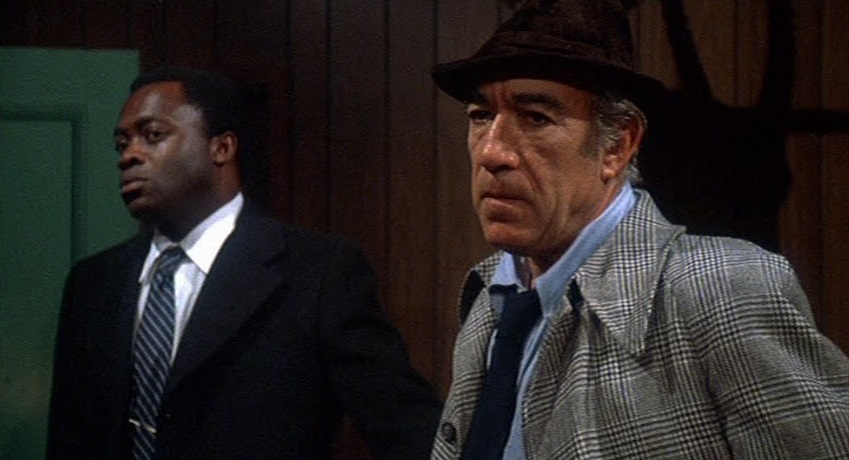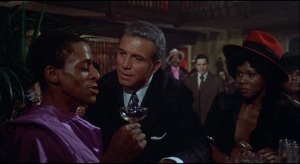
The holdup that begins the 1972 film Across 110th Street pits a trio of low-level amateurs against an established, well organized and, up to this point, efficient group of professional criminals. The end game is a case full of money, but what is ultimately achieved, more than monetary gain, is a scandalous affront to recognized power and unlawful street-level respectability. The bloody heist has two of the three hoods dressed as cops, and white gangsters collaborating with black gangsters (before they are unceremoniously mowed down by machine gun fire). And in this, the catalyst opening sequence serves to get the narrative moving and illustrates the blurred lines—cultural, political, racial, occupational—that will be repeatedly manipulated and confronted as the film progresses.

Anthony Quinn (who was also an executive producer, thus giving the modest production some star power, credibility, and a wider, white audience) costars as Capt. Mattelli, an old school cop who has earned street reverence and recognition as well as a blatantly racist reputation. Though apparently competent, his corrupt nature is also clear, from the way a witness instantly flinches when Quinn raises his hand to his own stated acceptance of criminal payoffs. Much to his chagrin, his partner, who is actually in charge of the case, is the African American Lt. Pope (Yaphet Kotto), a far more straight and narrow officer who nonetheless plays second fiddle in most sequences. Concurrently, there is Nick D’Salvio (Anthony Franciosa), a top Italian gangster, and Doc Johnson (Richard Ward), the head of the black mob prominent in Harlem. Their unsteady alliance is further threatened by the opening robbery, with each of their sides suffering losses (personnel and financial). The third narrative strand follows the lives of the three men behind the theft: Jim Harris (Paul Benjamin), Joe Logart (Ed Bernard), and Henry J. Jackson (Antonio Fargas).
These independent hoods are more complicated and roundly fleshed out than their peripheral placement would suggest. They are clearly in over their heads, and Henry J. is tragically and fatally careless in his post-robbery behavior (there’s always one), but there is a real humanity behind these three, a sympathetically pathetic quality. As Jean Renior famously noted, “everyone has his reasons” and screenwriter Luther Davis (working from a novel by Wally Ferris) does a fine job establishing the reasons behind the men: their hopes, dreams, and damaging foibles. Joe’s background is exceptionally developed and effectively potent. We bare witness to his dire straits and realize why he felt compelled to resort to this type of endeavor in the first place. He is a decent man driven to unfortunate action by racial and economic barriers. A scene in which Mattelli and Pope visit Henry J.’s estranged wife to inform her of his passing is quite touching as well. He was hit by a car, Pope tells her, wanting to spare her the harsh truth of her husband’s seedy demise: he was killed by gangsters while surrounded by drunks and whores.

The above and below 110th Street line is one of sharp racial divide, so in its very title, the film alerts to the breaching of such a partition. The power shifts between the police, the Italians, and the African Americans has as much to do with their literal strength, numbers, and spread as it does with the recognized influence of their respective ethnicities. In other words, they are only as powerful as their genetic makeup allows, which then, in turn, frequently dictates their placement in any given specific setting. By that same token, the tensions that mount often derive from their occupational endeavors as well as their social standing. And then, of course, race changes the game even more. That a black cop was killed during the opening raid is startling to many of the African Americans (killed by one of his own!); that white and black gangsters were also gunned down (while working together!) likewise stands out. Some even question why whites would even be in this part of Manhattan, that is, if not for some professional purpose: “What else brings whites to Harlem but business?” asks Pope.
Among its finer points, the way Across 110th Street deals with the racial realities of this locale, in a comparatively more adult and pragmatic fashion than its generic counterparts, is commendable and rather unexpected. The coincidence of the seemingly random robbery brings together cops and crooks all going after the same crew as well as each other, and, consequently, there is a fairly intricate exploration of a precarious and capricious quest for vengeance and punishment. Across 110th Street also raises some significant issues regarding the political and economic implications of this racial integration and the disputes between rival gangs and criminal control over various factions of the city. The racially divided power struggle within the police (embodied by Mattelli and Pope) mirrors the racial criminal divide of the gangsters, with parallel consequences of ulterior motives and secretive methods.

If one places Across 110th Street into the Blaxploitation category (a reasonable fit, if not a perfect one), the racial undertones are not surprising. However, what is usually self-evident yet in many ways taken for granted in films like Shaft (1971), The Mack (1973), and Super Fly (1972), is a point of crucial concern with this film. Indeed, the racial anxiety here is at the crux of the narrative; it is not simply raised in a passing reference to injustice (though make no mistake, there are moments of fleeting commentary, neighbors reluctant to cooperate with the police, refusing to “say anything to the man,” for example). Nor is the race related tumult the result of an African American action star adopting previously white genre types, something as obvious to the viewer as to the other characters in the film, both white and black. Those in Across 110th Street appear to be more realistically grounded and motivated than that.
That said, there is still a degree of stereotypical characterization in the film, from the brutal and corrupt police to the ethnic portrayals and their clichéd mannerisms (Henry J., in particular, is a ridiculously degrading archetype). It’s a common and unfortunate aspect of genre pictures like this: blanket molds standing in for well-defined characters. However, in the case of Across 110th Street we do often get personality behind the formulaic projection, as noted above, and what is more, where there are these conventional attributes they actually serve a meaningful purpose. Insofar as the film concerns the varying dividing lines of the city and its diverse enterprises and individuals, the character types act as icons of their respective ethnic associations. Their emblematic illustration opens the film’s narrative to a level of a sweeping symbolic examination. As localized as the film is, its themes, concerns, and characters are wide-ranging and applicable elsewhere.

The Internet Movie Database states that the Western film Doc watches at one point is Duel at Diablo (1966), “a western by Ralph Nelson, which also deals with an ethnic conflict (White soldiers against American Indians).” Granting this similarity, it would seem that the placement of a Western is otherwise in a somewhat ironic contrast. Generally, most conventional Westerns tend to revel in a clear good/bad dichotomy, so with that in mind, the stance of Across 110th Street is dissimilar to that of the standard cowboy vs. Indian trope. This film functions on the basis of dynamic and fluctuating notions of “good guys” and “bad guys.” After all, it is just prior to this that we find out Mattelli has been receiving kick-backs from Doc (“Dirty money, clean Money. It’s all the same,” says the gangster). Other than Pope, who seems to have no apparent shortcomings, the rest of the primary characters all reveal more ambiguous and wavering moral stances, or at least they run a precarious balance between audience appeal and disdain.
Barry Shear, best known in the movies for Wild in the Streets (1968) and for taking over The Deadly Trackers from Samuel Fuller in 1973, directed Across 110th Street. More prominently though, and more fitting in terms of Across 110th Street similarities, was his prolific career in television, especially crime dramas: one episode of Hawaii Five-O, two episodes of Mod Squad, six episodes of Ironside, the pilot episode of Starsky and Hutch, and one episode of The Streets of San Francisco, among others. Simply put, Shear knew his way around this type of material, and it shows.

The tangible 1970s grain of the cinematography (by Jack Priestley) and the diffused interior lighting mesh with Bobby Womack’s excellent music, most notably the title track (a better version of which opens Quentin Tarantino’s Jackie Brown (1997), to create a film unquestionably representative of its time of production. Across 110th Street and similar 70s crime films have always had something of an ethnographic and anthropologic appeal, in that their use of actual locations, street-wise jargon, and contemporary fashion and music are oftentimes vivid snapshots of a very specific people, location, and era. These consistently pronounced features of films during this period—particularly crime films, particularly crime films set in New York City—expose a certain sense of unadulterated popular reality, the grit and grime of a culture and setting wholly distinct and totally foreign to others.
There are a number of ways to look at Across 110th Street. Rough and raw and on occasion shockingly violent, it’s an exceptional police procedural. In tone, dialogue, and in many of its characterizations, it’s an exemplary entry into the Blaxploitation cycle. And in its realistic examination of the complexities of racial identification and significance, it’s a reasonably sophisticated drama. It is violent, sometimes graphically so, but never in an exploitative fashion. And though its final shot is heavy-handed (no pun intended), the depiction of this slice of street life is clever, entertaining, and perceptive.
REVIEW from FILM INTERNATIONAL
No comments:
Post a Comment